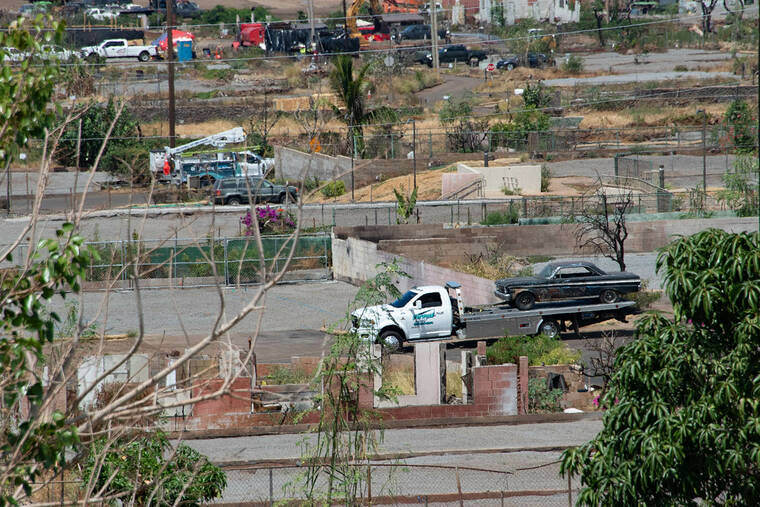Editorial: Lessons, hope on Maui fire anniversary

CRAIG T. KOJIMA / CKOJIMA@STARADVERTISER.COM
A view of Lahaina taken from Kelawea Mauka Makai Park on Lahainaluna Road in July.
The crises, challenges and sorrows of the devastating fire that ripped through Lahaina on Aug. 8 are still very much with us as the first anniversary of the disaster approaches.
The fire was the most deadly blaze in the U.S. in more than a century, resulting in 102 deaths, and the sense of loss over these lives cut short remains palpable.
The wind-whipped fire imposed huge losses on the town of Lahaina, flattening the historic district, destroying more than 2,200 structures and displacing more than 3,000 households. Yet the horrific circumstances gave rise to determined efforts to meet the needs of those affected, and also, urgently, to ensure that people throughout Hawaii are never again caught ill-prepared and unaware in the same fashion.
Hawaii must remain dedicated to these endeavors, knowing that should our state succeed, it will be a legacy due to the fire’s victims and their survivors.
Some key lessons that cannot be forgotten:
>> Statewide, advanced prevention and preparation methods must be developed and expanded. Pressing issues include measures required of Hawaiian Electric to prevent its power lines from sparking fire. The utility and emergency responders must develop techniques to speedily detect and pinpoint fire when it does occur. Individuals and business owners must be fire-aware, protecting their properties to the extent possible and preparing an emergency response.
Don't miss out on what's happening!
Stay in touch with breaking news, as it happens, conveniently in your email inbox. It's FREE!
>> Rebuilding and providing shelter for those affected by the fires — and coming to terms with Maui’s crisis-level shortage of affordable housing — is and must be a priority. Here, the Legislature has been responsive, and federal assistance has been key: In the past year, the feds have provided more than $1 billion for Maui’s recovery.
>> Housing solutions are needed to serve the entire county, and local residents have become vocal and persistent in calling for them. The need for affordable housing and resulting move to eliminate short-term rentals in residential zones has created a rift between those who seek more affordable long-term housing and those who defend the use of property as a profit center; this must be resolved despite opposing views.
>> Making reparations for the losses suffered remains a monumental task. A staggering $3.29 billion has been claimed against insurance, as reported to the state’s Insurance Division, in more than 10,000 unique cases. Then on Friday came this landmark announcement: The state, Hawaiian Electric, Maui County, area landowners Kamehameha Schools and West Maui Land Co., Hawaiian Telcom and Spectrum agreed on terms to settle claims from the disaster, making more than $4 billion available. Finalizing this settlement will go far in providing closure to fire victims, and is a significant development.
Challenges remain, and certainly Maui has not been left whole in the fire’s aftermath. Difficult questions about the adequacy and effectiveness of Maui County’s response to the wildfire linger, and diligent investigation is required, as is a commitment to uncover processes that must be repaired, learned or invented to prevent or limit effects of future disaster.
Further, gaps and inadequacies have been revealed in service providers’ ability to communicate with and aid displaced people from underserved groups, including immigrant and migrant workers, and families and individuals who were unsheltered in Lahaina when the fire occurred. To the credit of Hawaii’s governor, Legislature, and the many individuals and organizations that stepped forward to help, however, a laudable will to find solutions and press forward has emerged.
Determination to move forward by facilitating healing and building resilience is required. Continued, extraordinary efforts will be essential — by social service and mental health providers, but also public and private institutions such as schools and hospitals, churches and community groups.
The value of a supportive, effective educational system comes to the fore in the wake of such loss, and the return of youth displaced from their homes or home school to Lahaina classrooms is a positive development.
Taking it a step further, the joining of community groups, the University of Hawaii and private donors to support Lahainaluna High School graduates this year — for the full two or four years in tuition required to attend a UH campus, and for the first year of college for students going out of state — also provides reassurance.
These developments toward recovery are praiseworthy, and deserve emulation. The eager statewide and federally assisted cooperation to provide help for Lahaina fire survivors, and to insist on policies that secure a more hopeful future, should serve as a model for more actions that improve the lives of those on Maui — and throughout Hawaii.



